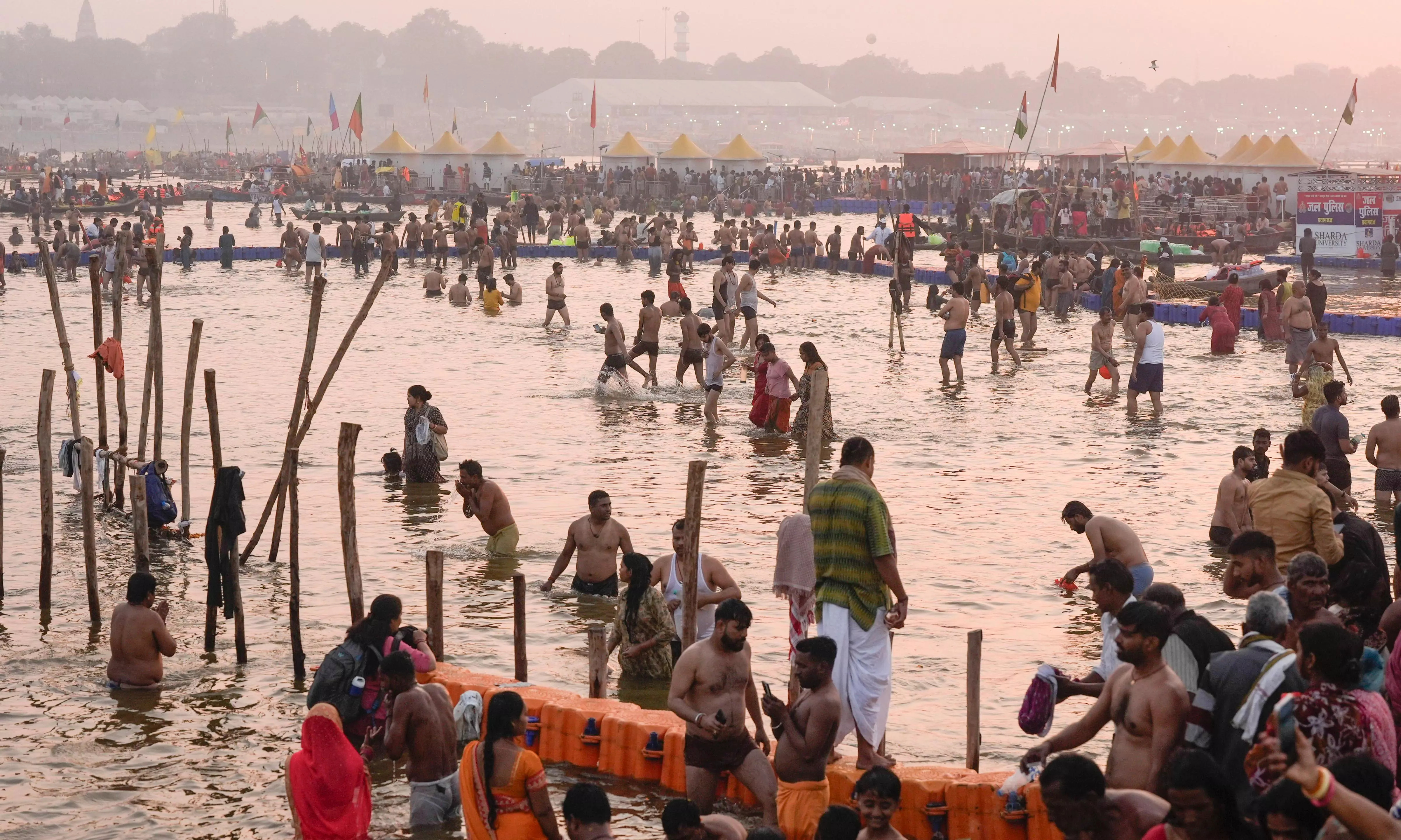After the Stampede, Ramps UP Efforts to Ensure Crowd Management, Devotees’ Safety

New Delhi/Prayagraj: A day after a stampede at the Maha Kumbh Mela left 30 people dead, the Uttar Pradesh government ramped up efforts to ensure crowd management and the safety of devotees who continued to flock in large numbers for the religious gathering.
The devotees were undeterred by the pre-dawn chill and reduced visibility due to the dense fog in their bid to take a dip in the Sangam and at other ghats on Thursday seeking “moksha” or salvation.
Pilgrims, including women and children, were seen walking to and fro the various ghats amid reduced visibility. Many had thin blankets covering their bodies while some stopped by bonfires along the routes to keep themselves warm.
A large number of devotees kept moving towards the Sangam from the Prayagraj city side via the Kachchap Dwar, while several others who had arrived for Mauni Amavasya and the subsequent rituals were seen heading back towards the city.
Considered among the holiest Hindu pilgrimages and held once in 12 years, the Kumbh Mela kicked off on January 13 and will continue till February 26. The tragedy struck on Wednesday when crores of devotees gathered near the Sangam -- the point where the Ganga, Yamuna and mythical Saraswati rivers meet --to take the traditional holy dip on one of the holiest days of the six-week event.
Maha Kumbh DIG Vaibhav Krishna said the incident took place due to crowd pressure. The crowd broke barricades and jumped to the other side, crushing those waiting there, he said. On Wednesday, more than 7.64 crore devotees had a “snan” at the Maha Kumbh, the highest in a single day so far.
A day after the tragedy, about two crore devotees reportedly took the holy dip by 4 pm on Thursday. So far, more than 28 crore devotees are said to have taken the holy dip.
As the state administration had come under fire from the Opposition parties for the tragic incident, the 30 pontoon bridges in the mela area on Thursday started operating under a one-way traffic system. This meant that each bridge allowed movement in only one direction, with a parallel pontoon bridge designated for return routes.
SP (Traffic) Anshuman Mishra said the area would now remain a no-vehicle zone until the crowd disperses completely. “Vehicle passes will not be valid until all devotees have safely left for their destinations. No outside vehicles would be allowed to enter the city until the crowd exits the Mela area,” he said. However, senior officials may grant permission for vehicle entry based on the situation, he said.
Mr Mishra clarified that essential services such as police administration vehicles, ambulances and suction machines would be allowed entry as they are crucial for the smooth management of the Maha Kumbh.
A three-member judicial commission set up by the Uttar Pradesh government to probe the Maha Kumbh stampede will also visit the site on Friday. Panel head Harsh Kumar, a retired judge of the Allahabad High Court, said that the commission has a month to wrap up its investigation but will try to expedite it. Mr Kumar and panel members -- former director-general of police V.K. Gupta and retired IAS officer D.K. Singh -- reached the office assigned to them and began their work on Thursday.
Mr Krishna said the police was actively working on security arrangements for the upcoming Amrit Snan on Basant Panchami Snan (February 3), ensuring tight security measures in the mela area. He said: “In anticipation of the large number of pilgrims expected, we are further strengthening the deployment of police personnel and security forces.”
Mr Krishna said that the crowd pressure was relatively lower on Thursday, and all bridges had been reopened, allowing smoother movement within the mela area. However, before Basant Panchami, new restrictions will be imposed at key locations for better crowd management.
DIG Krishna also clarified that according to the official guidelines, there was no VIP movement in the mela area on Mauni Amavasya, and the same protocol will be followed for Basant Panchami. After dense fog in the morning, the weather gradually cleared, and bright sunshine spread across the Kumbh Mela area. However, the influx of pilgrims towards Sangam and other ghats remained constant throughout the day.
At Prayagraj, Geeta Agarwal, who travelled from Guwahati in Assam with her family, said, “I had come with my children and grandchildren to take a holy dip on Mauni Amavasya, but due to the overwhelming crowd, we couldn't reach Triveni Sangam. Today, we are trying again, but if we can't make it, we will take a dip at another ghat to seek blessings.” She also mentioned facing difficulties navigating the mela area, as directions were unclear at multiple spots. On Wednesday, she had to rely on others' guidance several times, which sometimes led her in the wrong direction.
The Triveni Sangam, considered the most sacred bathing site, is located on one side of the mela area, while several other ghats, situated along the Ganga and closer to the akharas, are on the opposite side, connected by these pontoon bridges.
Pramod Panwar, who hails from Gurgaon, Haryana, said he reached on Wednesday with his family and was returning now. “We took a dip early today. We came here yesterday but it was very crowded. Today the situation is better. We thank Modi and Yogi for the arrangements,” he said.
Delhi resident Asha Patel was also among those who took a dip. “We keep hearing something good or bad about what's happening but we don't focus on that. I had been wanting to come to the Maha Kumbh for a long time and finally it happened. Thanks to Modi, Yogi, our gods and ancestors,” she said.
